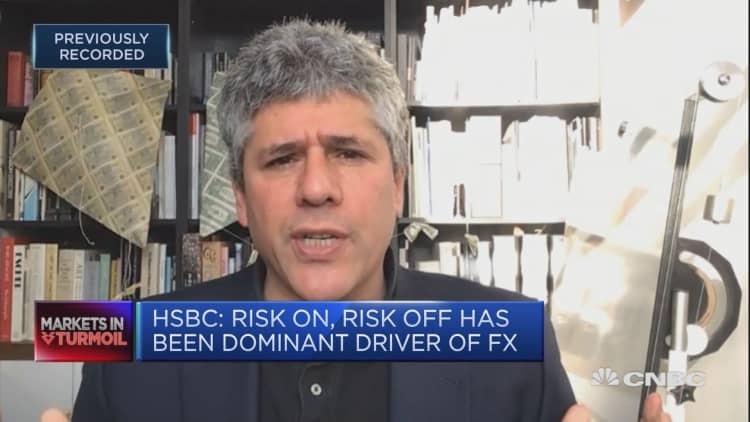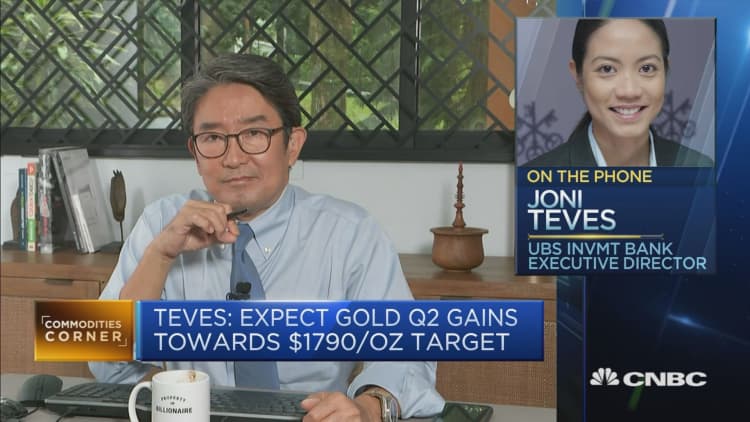The global economy is most likely set for a U-shaped recovery with a "jagged bottom" after the coronavirus crisis, and will benefit currencies in countries with strong fiscal positions, according to HSBC.
Speaking to CNBC Monday, Head of Global Foreign Exchange Strategy David Bloom outlined the bank's game plan in the event of L-, U- and V-shaped recoveries, emphasizing that analysts should be making plans for all eventualities.
In a U-shaped scenario, the economy fails to respond immediately to exits from lockdowns around the world, but the expectation for a delayed rebound remains in place with multiple "false dawns," Bloom suggested, causing a "jagged bottom" to the U curve.
Jagged U
He suggested that while the situation is unlikely to worsen beyond last month's unprecedented crash in oil price futures to negative $40 and tens of millions of job losses, the assumption of a V-shaped recovery similar to the one that emerged after the financial crisis was optimistic.
"It is much more likely that we are in this kind of U with a jagged bottom scenario, and the (U.S.) dollar kind of does well but this is your NOK (Norwegian krone), your yen, your Aussie, your Kiwi," Bloom told CNBC's "Squawk Box Europe."
"Some of them have great fiscal firepower to keep trying to push this economy. Even if it doesn't come, they're doing another fiscal package and they've got the money."

While the dollar and the Japanese yen are expected to benefit from the initial rise in volatility, central to HSBC's backing of the Norwegian krone, Australian dollar and New Zealand dollar is their respective governments' low debt levels.
This gives them more room for fiscal stimulus as federal governments continue to try to shore up their economies, and these policy moves will likely emerge as a key driver of currency movement once the health crisis subsides.
The losers in this scenario, Bloom projected in a research note last week, include sterling and the Canadian dollar, since both governments' fiscal room is limited, while the euro would struggle on the back of stressed finances in Italy and Spain.
L-shaped lag
In an L-shaped scenario, where low growth, low inflation and low commodity prices foster a prolonged "risk off" sentiment in markets, foreign exchange trends will likely be driven by external factors and vulnerabilities, Bloom said in the note.
This lends itself well to the yen, due to Japan's strong international investment position (IIP) and 30 years' experience with similar economic dynamics at the domestic level. The Swiss franc and Norwegian krone also stand to benefit due to "strong external positions," but Bloom suggested that the real winner in this scenario would be gold.

"The market is just whipping around at the moment on a risk-on risk-off scenario," he told CNBC.
"Gold is looking like a winner at the moment, gold is the true love. In a V, gold gets destroyed, in other scenarios it does very well, so Swiss (francs), yen, gold, those are the defensive currencies to own," Bloom recommended, adding that those anticipating a more aggressive V-shape should look to Australia and New Zealand.
V-shaped bounce
In the unlikely V-shape recovery scenario, these two currencies alongside the Norwegian krone and the Canadian dollar are ones to watch, Bloom suggested in the note, given that they have been most adversely affected during the "risk-off" period and thus have further to rebound.
"They are also best placed to capitalize on the commodity price gains alongside the economic upswing," Bloom added.
While the Norwegian krone is among the best positioned currencies across all three recovery scenarios, however, it would be one of the most exposed should none of these transpire and the economic situation worsens.

This would entail an extension of lockdown measures, possibly due to a second wave of Covid-19, with policy actions such as monetization of the deficit or new FX regulations becoming more likely.
Here, gold would be the standout winner, according to HSBC analysts, with the U.S. dollar and the yen also gaining as traditional "safe havens" while all four of those mentioned above would be exposed.

